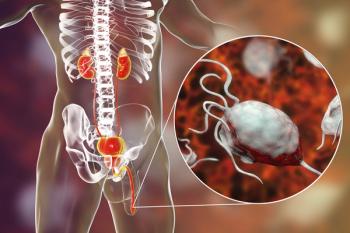
Radical Prostatectomy Plus Radiotherapy Extends OS in Prostate Cancer
A study in Cancer found a lower risk of prostate cancer–specific death and improved overall survival when patients were treated with this combination.
Men with locally or regionally advanced prostate cancer treated initially with radical prostatectomy (RP) and adjuvant radiotherapy may have a lower risk of prostate cancer–specific death and improved overall survival (OS) compared with men treated with radiotherapy plus androgen deprivation therapy (ADT), according to research
Using Surveillance, Epidemiology, and End Results (SEER)–Medicare data, researchers evaluated 13,856 men with high-risk to very high-risk prostate cancers. The cohort included men with locally advanced disease (T3-T4, N0, M0) and regionally advanced disease (T3-T4, N1, M0). Both treatment groups were matched by age, race, comorbid conditions, as well as tumor and nodal stage to control for factors that may influence outcomes. They then analyzed which group fared better 10 to 15 years after treatment.
“We found men who received RP with adjuvant radiotherapy were less likely to die from prostate cancer and lived longer in comparison to men who received radiotherapy plus ADT. The survival advantage benefited those men without regional lymph node metastasis most. However, patients who received RP with adjuvant radiotherapy experienced higher rates of erectile dysfunction and urinary incontinence when compared to those in the radiotherapy plus ADT group,” said study author
Jang and his colleagues conducted this study because little comparative data from well-controlled studies or randomized trials exist that compare these two substantially different treatment approaches, according to Jang.
In this study, all men were age 65 or older and were treated between 1992 and 2009. Among 13,856 men, 6.1% received RP plus radiotherapy and 23.6% received radiotherapy plus ADT.
A total of 2,189 deaths occurred in the cohort (702 secondary to prostate cancer) at a median followâup of 14.6 years. The study showed that, regardless of tumor stage or Gleason score, the adjusted 10âyear prostate cancer–specific survival and 10âyear OS favored men who underwent RP plus radiotherapy. However, men in the RP group experienced higher rates of erectile dysfunction (28% vs 20%) and urinary incontinence (49% vs 19%).
According to Lang, survival data from the current study can help clinicians better counsel men on outcomes after treatment. He said that the adjusted 10-year prostate cancer–specific survival rates for men with T3a/b, N0, M0 disease, T3a/b N1, M0 disease, and T4, N0, M0 disease were 88.9%, 75.7%, and 72%, respectively, for those who received RP plus radiotherapy and 74.2%, 58.6%, and 60.5%, respectively, for those who received radiotherapy plus ADT.
“The survival and functional outcomes data in our study need to be verified in the setting of a prospective clinical trial, and the data suggests the need to include a surgical arm in future trials for men with high-risk to very high-risk prostate cancer,” Dr. Jang told Cancer Network.
Newsletter
Stay up to date on recent advances in the multidisciplinary approach to cancer.


















































































